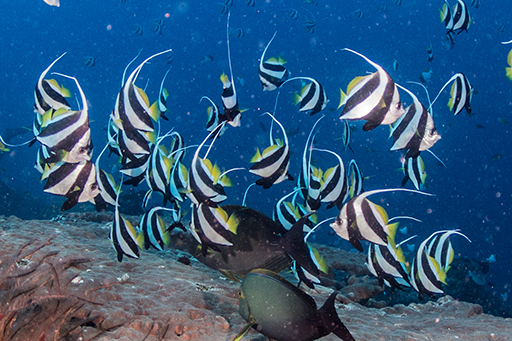Visually Separating the Bannerfishes: Longfin versus Schooling
The two fish Longfin Bannerfish, Heniochus acuminatus, and Schooling Bannerfish, H. diphreutes, are very similar. Observers often confuse them when seen while diving or snorkeling. There are several ways to tell them apart.
Behavior is easiest. If you see many of them at once in a loose school, it is the Schooling Bannerfish. If you see just one or two (or occasionally three), then it is likely the Longfin Bannerfish. While Longfins may wander about the reef, schools of the Schooling are often found in the same place on the reef on repeat visits and rarely seem to move.

But what if you see a small group, or a photo taken out of context, or an aquarium specimen? There are three field marks to look for in adults.

Examine the lower rear corner of the fish where the anal fin forms a point. This point will be part white and part black. Where that transition happens is different in the two species. In the Schooling Bannerfish, the dividing line between white and black exactly hits the corner. In the Longfin Bannerfish, the division is just a little further back, so that the corner itself is clearly white, and the black starts a little beyond the corner. However, this changes somewhat with the movement of the fin as the fish swims, so this character is best considered in combination with others.
Look at the base of the pennant, the long white spine of the dorsal fin. There are a few spines in front of it that are short and black. These are different lengths on the two species. On the Schooling Bannerfish, the black in front of the pennant is long, sticking far enough up the front of the pennant that when the pennant is folded back it will be above the top of the rear black body bar. On the Longfin Bannerfish, that black spine in front of the pennant is much shorter, it could never reach across the white to the second black body bar.
Look at the angle formed where the lower edge of the tail and the anal fin come together. It is much sharper in the Longfin Bannerfish (usually less than 45 degrees), than in Schooling Bannerfish (usually 60 degrees or more).
Finally, the shape of the breast is different in the two species. In the Schooling Bannerfish, it is clearly rounded, while in the Longfin Bannerfish it is more flattened.
If you have a really sharp close photo, you can reliably separate them by counting the spines in the dorsal fin. The Schooling Bannerfish has 12, whereas the Longfin Bannerfish has only 11. Note this is just the stiff spines (including the one in the pennant), not the soft rays. This applies to juveniles as well as adults.
Some people cite the color of the snout between the mouth and eyes, which you can see in the two photos above is dusky in the Longfin Bannerfish and pale in the Schooling Bannerfish. However, I have not found this to be reliable in separating them.
